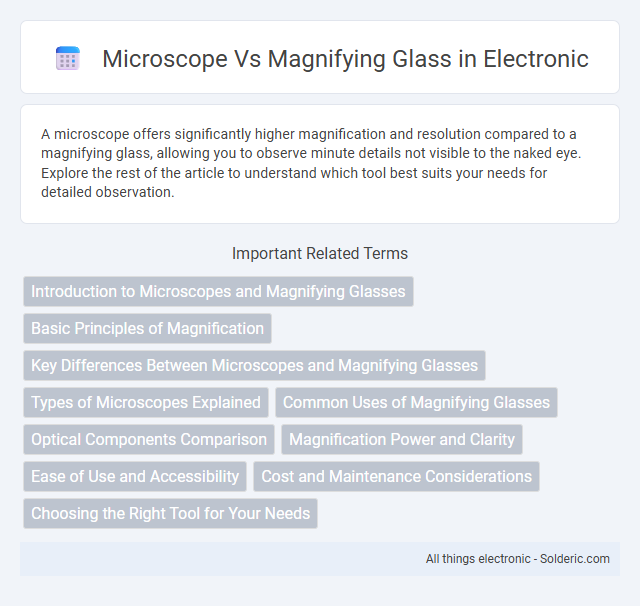A microscope offers significantly higher magnification and resolution compared to a magnifying glass, allowing you to observe minute details not visible to the naked eye. Explore the rest of the article to understand which tool best suits your needs for detailed observation.
Comparison Table
| Feature | Microscope | Magnifying Glass |
|---|---|---|
| Function | Magnifies tiny objects for detailed examination | Enlarges objects for casual viewing |
| Magnification Power | Typically 40x to 1000x or more | Usually 2x to 10x |
| Complexity | Advanced optical system with multiple lenses | Simple convex lens |
| Usage | Scientific research, medical labs, education | Reading small text, hobby, fieldwork |
| Portability | Less portable, requires stable setup | Highly portable, handheld |
| Price Range | From $50 to several thousand dollars | Usually under $20 |
Introduction to Microscopes and Magnifying Glasses
Microscopes and magnifying glasses are optical instruments designed to enlarge the appearance of objects, yet they serve different purposes and offer varying levels of magnification. Magnifying glasses, typically handheld with a single convex lens, provide low magnification ideal for casual observation of small details. Microscopes use multiple lenses and complex optical systems to achieve high magnification and resolution, enabling the study of microscopic structures invisible to the naked eye.
Basic Principles of Magnification
Microscopes utilize multiple lenses arranged in a series to achieve high levels of magnification, often exceeding 1000x, allowing detailed observation of microscopic structures. Magnifying glasses rely on a single convex lens to enlarge objects typically up to 10x magnification, suitable for everyday tasks requiring mild enhancement. The fundamental difference lies in how microscopes manipulate light paths through compound lenses versus the simple magnification through one lens in magnifying glasses.
Key Differences Between Microscopes and Magnifying Glasses
Microscopes provide significantly higher magnification levels, often exceeding 1000x, enabling detailed visualization of microscopic structures, whereas magnifying glasses typically offer up to 10x magnification for viewing larger objects. Microscopes feature complex optical systems with multiple lenses and adjustable focus to enhance resolution and clarity, while magnifying glasses consist of a single convex lens with a fixed focal length. The use of microscopes is essential in scientific research and medical diagnostics due to their precision, contrasting with magnifying glasses' suitability for casual inspection and reading assistance.
Types of Microscopes Explained
Microscopes come in various types including optical, electron, and digital microscopes, each designed for specific magnification needs and resolution capabilities beyond what a magnifying glass offers. Optical microscopes use lenses and light to magnify objects up to 2000 times, suitable for viewing cells and bacteria, whereas electron microscopes leverage electron beams for magnification up to two million times, revealing ultrastructures at the molecular level. Your choice depends on the level of detail you need, with magnifying glasses offering a simple, low-power alternative for basic magnification tasks.
Common Uses of Magnifying Glasses
Magnifying glasses are commonly used for detailed tasks such as reading small print, examining stamps or coins, and assisting with hobbies like model building or needlework. They provide portable, low-magnification enhancement typically ranging from 2x to 10x, making them ideal for quick visual inspections without the need for complex setup. Unlike microscopes, magnifying glasses offer convenience and ease of use in everyday scenarios requiring moderate zoom.
Optical Components Comparison
Microscopes utilize complex optical components such as multiple lenses including objective and ocular lenses, which provide high magnification and resolution for viewing minute details at cellular or even molecular levels. Magnifying glasses rely on a single convex lens that offers lower magnification, typically ranging from 2x to 10x, suitable for general close-up observation of objects. The precision and arrangement of optical components in microscopes enable detailed, high-contrast imaging, whereas magnifying glasses provide a simplified, portable solution with limited depth of field and clarity.
Magnification Power and Clarity
Microscopes offer significantly higher magnification power, often ranging from 40x to over 1000x, allowing you to view intricate details at the cellular level. Magnifying glasses typically provide low magnification, usually between 2x and 10x, suitable for general enlarging of objects but lacking the clarity and resolution of a microscope. The superior lens quality and optical design of microscopes ensure enhanced clarity and precision, making them essential for scientific and medical observation.
Ease of Use and Accessibility
Magnifying glasses offer simplicity and straightforward use, requiring no special training and providing quick magnification for everyday tasks. Microscopes, while delivering higher magnification and detailed viewing, often require adjustments and some basic knowledge to operate effectively. Your choice depends on the balance between the need for ease of use with a magnifying glass versus the detailed observation capabilities of a microscope.
Cost and Maintenance Considerations
Microscopes generally require higher initial investment and regular maintenance, including calibration and lens cleaning, making them costlier over time compared to magnifying glasses. Magnifying glasses offer a budget-friendly option with minimal upkeep, primarily involving occasional lens cleaning and storage precautions. For educational or hobby use, magnifying glasses provide affordable durability, whereas microscopes suit professional or detailed examination needs despite higher costs.
Choosing the Right Tool for Your Needs
Microscopes provide high magnification and detailed views of tiny structures, ideal for scientific research and precise examination, while magnifying glasses offer lower magnification suitable for general tasks like reading small text or inspecting objects. Your choice depends on the level of detail and portability required; microscopes are best for in-depth analysis, whereas magnifying glasses are convenient for quick, everyday use. Understanding these key differences ensures you select the right tool to effectively meet your specific needs.
microscope vs magnifying glass Infographic

 solderic.com
solderic.com